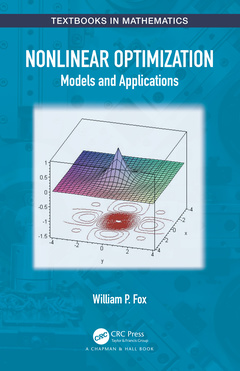Nonlinear Optimization Models and Applications Textbooks in Mathematics Series

Optimization is the act of obtaining the "best" result under given circumstances. In design, construction, and maintenance of any engineering system, engineers must make technological and managerial decisions to minimize either the effort or cost required or to maximize benefits. There is no single method available for solving all optimization problems efficiently. Several optimization methods have been developed for different types of problems. The optimum-seeking methods are mathematical programming techniques (specifically, nonlinear programming techniques).
Nonlinear Optimization: Models and Applications presents the concepts in several ways to foster understanding. Geometric interpretation: is used to re-enforce the concepts and to foster understanding of the mathematical procedures. The student sees that many problems can be analyzed, and approximate solutions found before analytical solutions techniques are applied. Numerical approximations: early on, the student is exposed to numerical techniques. These numerical procedures are algorithmic and iterative. Worksheets are provided in Excel, MATLAB®, and Maple? to facilitate the procedure. Algorithms: all algorithms are provided with a step-by-step format. Examples follow the summary to illustrate its use and application.
Nonlinear Optimization: Models and Applications:
- Emphasizes process and interpretation throughout
- Presents a general classification of optimization problems
- Addresses situations that lead to models illustrating many types of optimization problems
- Emphasizes model formulations
- Addresses a special class of problems that can be solved using only elementary calculus
- Emphasizes model solution and model sensitivity analysis
About the author:
William P. Fox is an emeritus professor in the Department of Defense Analysis at the Naval Postgraduate School. He received his Ph.D. at Clemson University and has taught at the United States Military Academy and at Francis Marion University where he was the chair of mathematics. He has written many publications, including over 20 books and over 150 journal articles. Currently, he is an adjunct professor in the Department of Mathematics at the College of William and Mary. He is the emeritus director of both the High School Mathematical Contest in Modeling and the Mathematical Contest in Modeling.
Chapter 1. Nonlinear Optimization Overview
1.1 Introduction
1.2 Modeling
1.3 Exercises
Chapter 2. Review of Single Variable Calculus Topics
2.1 Limits
2.2 Continuity
2.3 Differentiation
2.4 Convexity
Chapter 3. Single Variable Optimization
3.1 Introduction
3.2 Optimization Applications
3.3 Optimization Models
Constrained Optimization by Calculus
Chapter 4. Single Variable Search Methods
4.1 Introduction
4.2 Unrestricted Search
4.3 Dichotomous Search
4.4 Golden Section Search
4.5 Fibonacci Search
4.6 Newton’s Method
4.7 Bisection Derivative Search
Chapter 5. Review of MV Calculus Topics
5.1 Introduction, Basic Theory, and Partial Derivatives
5.2 Directional Derivatives and The Gradient
Chapter 6. MV Optimization
6.1 Introduction
6.2 The Hessian
6.3 Unconstrained Optimization
Convexity and The Hessian Matrix
Max and Min Problems with Several Variables
Chapter 7. Multi-variable Search Methods
7.1 Introduction
7.2 Gradient Search
7.3 Modified Newton’s Method
Chapter 8. Equality Constrained Optimization: Lagrange Multipliers
8.1 Introduction and Theory
8.2 Graphical Interpretation
8.3 Computational Methods
8.4 Modeling and Applications
Chapter 9. Inequality Constrained Optimization; Kuhn-Tucker Methods
9.1 Introduction
9.2 Basic Theory
9.3 Graphical Interpretation and Computational Methods
9.4 Modeling and Applications
Chapter 10. Method of Feasible Directions and Other Special NL Methods
10.1 Methods of Feasible Directions
Numerical methods (Directional Searches)
Starting Point Methods
10.2 Separable Programming
10.3 Quadratic Programming
Chapter 11. Dynamic Programming
11.1 Introduction
11.2 Continuous Dynamic Programming
11.3 Modeling and Applications with Continuous DP
11.4 Discrete Dynamic Programming
11.5 Modeling and Applications with Discrete Dynamic Programming
Date de parution : 12-2020
15.6x23.4 cm
Thèmes de Nonlinear Optimization :
Mots-clés :
Economic Order Quantity; Nonlinear optimization; NLP Problem; Numerical approximations; Number Function Evaluations; Model sensitivity analysis; Vice Versa; Geometric interpretation; Golden Section Search; Nonlinear programming techniques; Simplex Method; Hessian Matrix; Newton’s Method; EOQ Model; Shadow Price; Peripheral Computer; Lagrangian Function; SP6 Computer; Total Cost; Final Interval; CS; Non-basic Variables; Golden Section Method; Point P1 P4; Feasible Directions; Interior Point Methods; DP Problem; Piecewise Linear Approximation; Kuhn Tucker Conditions; Unconstrained Nonlinear Optimization Problem



